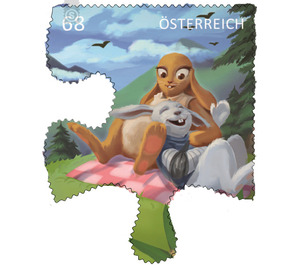Comic brand Puzzle - Austria / II. Republic of Austria 2015 - 68 Euro Cent
Theme: Art & Culture
| Country | Austria / II. Republic of Austria |
| Issue Date | 2015 |
| Face Value | 68.00 |
| Edition Issued | 150,000 |
| Printing Type | offset |
| Stamp Type | Commemorative |
| Item Type | Stamp |
| Chronological Issue Number | 2539 |
| Chronological Chapter | OOS-OE2 |
| SID | 696584 |
| In 19 Wishlists | |
The historians speculate about the age of the Easter Bunny and come up with different theories. The egg-bearing rodent was first mentioned in writing in 1682 in a book by the Heidelberg physician Georg Franck von Franckenau or his doctoral student Johannes Richier: "De ovis paschalibus" ("From Easter Eggs"). It is about the Easter Bunny, who hides eggs in gardens, thus delighting children as well as adults. Already in antiquity, the hare was a symbol of life, fertility and growth and was taken up again and again in art as well as in church representations. The well-known "Three-Rabbit Picture", which depicts three rabbits arranged in a circle with only three ears, is a symbol of the Holy Trinity and was early used as a motif for the painting of Easter eggs - possibly the story of the rabbit, the eggs brings. The spring-related propagation of the hares and the associated forced foraging may have contributed to the fact that the Easter bunny prevailed in the 18th century, especially in the urban areas as an Easter symbolic animal. In the well-to-do bourgeoisie of the 19th century, the search for the Easter eggs gradually turned into a family tradition, and religious origins became more and more obsolete in many places. Incidentally, the Easter bunny owes its sustainable appearance to the Bavarian official Franz Graf von Pocci, who once let his imagination run wild with his illustrations of the standing rabbit with a basket full of eggs. The four self-adhesive stamps, together with the earlier editions of this series, together make up the overall picture. Each stamp represents a perforated puzzle piece, one of four individual pictures and a franking stamp valid at a nominal value of 0.68 Euro each ,


